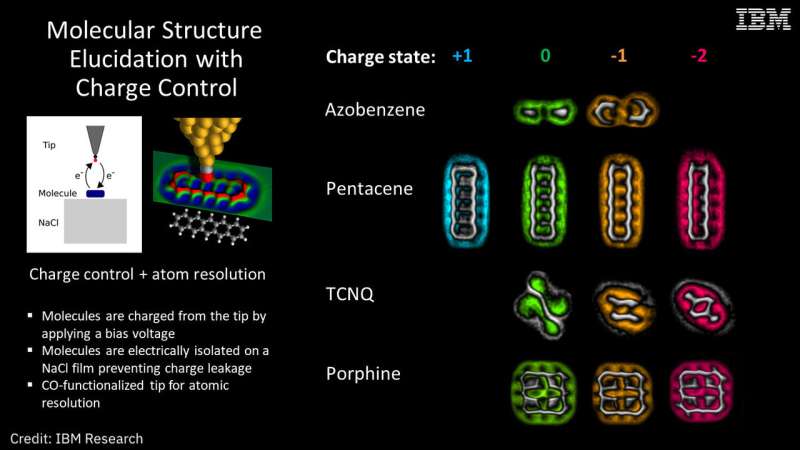July 12, 2019 report
Researchers image molecules as they change charge states for first time

A team of researchers from IBM Research–Zurich, ExxonMobil Research and Engineering Company and Universidade de Santiago de Compostela has, for the first time, imaged molecules as they change charge states. In their paper published in the journal Science, the group describes how they created the images and what they saw.
Scientists have known for some time that molecules change when they are charged, both in function and structure. But until now, they have not been able to see it in action. In this new effort, the researchers have made images of four molecules—azobenzene, pentacene, TCNQ and porphine—as they underwent changes due to charging. They note that molecular charging is at the very heart of many very important biological processes, such as energy transport and photoconversion—thus, observing what it looks like when it happens is very important.
To create the images, the researchers placed a single molecule on an isolated NaCl film and then used high-resolution atomic force microscopy in a very cold vacuum environment to transfer a single electron from the probe tip to the molecule. Imaging was carried out using carbon monoxide-functionalized tips. Each of the molecules was imaged in four states: positive, neutral, negative and double-negative (adding two electrons).
The researchers observed structural changes in all of the molecules, and that each was changed in a different way than the others. With pentacene, for example, the team saw which areas of the molecule became more reactive. With TCNQ, they observed changes in the bonds between the atoms in the molecule—and they also noted that it moved relative to its base. And with porphine, they observed changes to the types of bonds and their lengths. They also noted that porphine, in particular, plays a critical role in biological processing—it is involved in the process of hemoglobin transporting oxygen in living organisms. Being able to see what happens to a molecule as it is charged can help to better understand how the whole transport process works. The team further suggests that using techniques such as imaging molecular charge states will help with the development of new materials and devices—and will improve our understanding of nature in general.
More information: Molecular structure elucidation with charge-state control, Science 12 Jul 2019: Vol. 365, Issue 6449, pp. 142-145, DOI: 10.1126/science.aax5895 , https://science.sciencemag.org/content/365/6449/142
Researcher's blog: www.ibm.com/blogs/research/201 … cules-charge-states/
Journal information: Science
© 2019 Science X Network



















